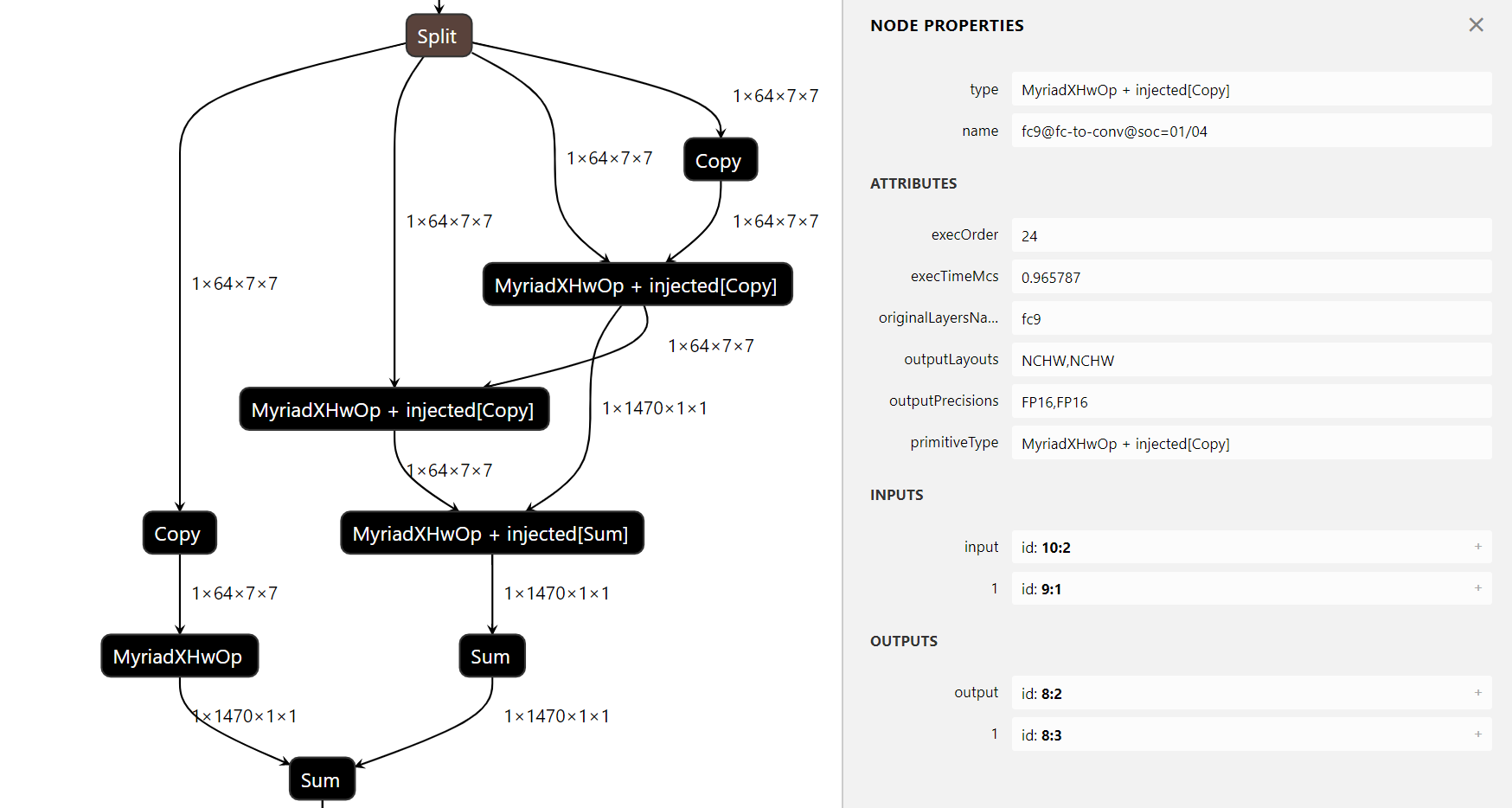VPU devices¶
This chapter provides information on the OpenVINO Runtime plugins that enable inference of deep learning models on the supported VPU devices:
Intel® Neural Compute Stick 2 powered by the Intel® Movidius™ Myriad™ X — Supported by the MYRIAD Plugin
Intel® Vision Accelerator Design with Intel® Movidius™ VPUs — Supported by the HDDL Plugin
Note
With the OpenVINO™ 2020.4 release, Intel® Movidius™ Neural Compute Stick powered by the Intel® Movidius™ Myriad™ 2 is no longer supported.
Supported Networks¶
Caffe* :
AlexNet
CaffeNet
GoogleNet (Inception) v1, v2, v4
VGG family (VGG16, VGG19)
SqueezeNet v1.0, v1.1
ResNet v1 family (18***, 50, 101, 152)
MobileNet (mobilenet-v1-1.0-224, mobilenet-v2)
Inception ResNet v2
DenseNet family (121,161,169,201)
SSD-300, SSD-512, SSD-MobileNet, SSD-GoogleNet, SSD-SqueezeNet
TensorFlow* :
AlexNet
Inception v1, v2, v3, v4
Inception ResNet v2
MobileNet v1, v2
ResNet v1 family (50, 101, 152)
ResNet v2 family (50, 101, 152)
SqueezeNet v1.0, v1.1
VGG family (VGG16, VGG19)
Yolo family (yolo-v2, yolo-v3, tiny-yolo-v1, tiny-yolo-v2, tiny-yolo-v3)
faster_rcnn_inception_v2, faster_rcnn_resnet101
ssd_mobilenet_v1
DeepLab-v3+
MXNet* :
AlexNet and CaffeNet
DenseNet family (121,161,169,201)
SqueezeNet v1.1
MobileNet v1, v2
NiN
ResNet v1 (101, 152)
ResNet v2 (101)
SqueezeNet v1.1
VGG family (VGG16, VGG19)
SSD-Inception-v3, SSD-MobileNet, SSD-ResNet-50, SSD-300
*** Network is tested on Intel Neural Compute Stick 2 with BatchNormalization fusion optimization disabled during Model Optimizer import
Optimizations¶
VPU plugins support layer fusion and decomposition.
Layer Fusion¶
Fusing Rules¶
Certain layers can be merged into convolution, ReLU, and Eltwise layers according to the patterns below:
Convolution
Convolution + ReLU → Convolution
Convolution + Clamp → Convolution
Convolution + LeakyReLU → Convolution
Convolution (3x3, stride=1, padding=1) + Pooling (2x2, stride=2, padding=0) → Convolution
Pooling + ReLU → Pooling
FullyConnected + ReLU → FullyConnected
Eltwise
Eltwise + ReLU → Eltwise
Eltwise + LeakyReLU → Eltwise
Eltwise + Clamp → Eltwise
Joining Rules¶
Note
Application of these rules depends on tensor sizes and resources available.
Layers can be joined only when the two conditions below are met:
Layers are located on topologically independent branches.
Layers can be executed simultaneously on the same hardware units.
Decomposition Rules¶
Convolution and Pooling layers are tiled resulting in the following pattern:
A Split layer that splits tensors into tiles
A set of tiles, optionally with service layers like Copy
Depending on a tiling scheme, a Concatenation or Sum layer that joins all resulting tensors into one and restores the full blob that contains the result of a tiled operation
Names of tiled layers contain the
@soc=M/Npart, whereMis the tile number andNis the number of tiles:
Note
Nominal layers, such as Shrink and Expand, are not executed.
Note
VPU plugins can add extra layers like Copy.
VPU Common Configuration Parameters¶
VPU plugins support the configuration parameters listed below. The parameters are passed as std::map<std::string, std::string> on InferenceEngine::Core::LoadNetwork or InferenceEngine::Core::SetConfig. When specifying key values as raw strings (that is, when using Python API), omit the KEY_ prefix.
Parameter Name |
Parameter Values |
Default |
Description |
|---|---|---|---|
|
|
|
Turn on HW stages usage Applicable for Intel Movidius Myriad X and Intel Vision Accelerator Design devices only. |
|
|
|
Specify internal input and output layouts for network layers. |
|
|
|
Add device-side time spent waiting for input to PerformanceCounts. See Data Transfer Pipelining section for details. |
|
|
|
VPU plugin could use statistic present in IR in order to try to improve calculations precision. If you don’t want statistic to be used enable this option. |
|
path to XML file |
empty string |
This option allows to pass XML file with custom layers binding. If layer is present in such file, it would be used during inference even if the layer is natively supported. |
Data Transfer Pipelining¶
MYRIAD plugin tries to pipeline data transfer to/from device with computations. While one infer request is executed, the data for next infer request can be uploaded to device in parallel. The same applies to result downloading.
KEY_VPU_PRINT_RECEIVE_TENSOR_TIME configuration parameter can be used to check the efficiency of current pipelining. The new record in performance counters will show the time that device spent waiting for input before starting the inference. In a perfect pipeline this time should be near zero, which means that the data was already transferred when new inference started.
Troubleshooting¶
Get the following message when running inference with the VPU plugin: “[VPU] Cannot convert layer <layer_name> due to unsupported layer type <layer_type>”
This means that your topology has a layer that is unsupported by your target VPU plugin. To resolve this issue, you can implement the custom layer for the target device using the OpenVINO™ Extensibility mechanism. Or, to quickly get a working prototype, you can use the heterogeneous scenario with the default fallback policy (see the Heterogeneous execution section). Use the HETERO mode with a fallback device that supports this layer, for example, CPU: HETERO:MYRIAD,CPU. For a list of VPU-supported layers, see the Supported Layers section of the Supported Devices page.
Known Layers Limitations¶
ScaleShiftlayer is supported for zero value ofbroadcastattribute only.CTCGreedyDecoderlayer works with thectc_merge_repeatedattribute equal to 1.DetectionOutputlayer works with zero values ofinterpolate_orientationandnum_orient_classesparameters only.MVNlayer uses fixed value forepsparameters (1e-9).Normalizelayer uses fixed value forepsparameters (1e-9) and is supported for zero value ofacross_spatialonly.Padlayer works only with 4D tensors.